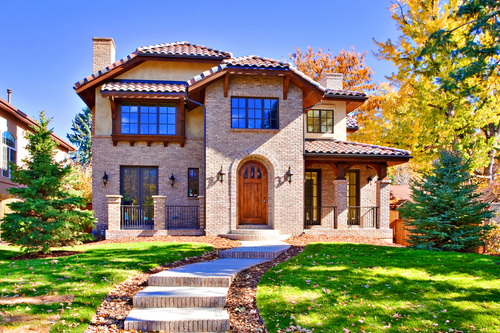2.9 Million Colorado Homeowners Live in Wildfire Areas

Two story, all brick luxury home in Denver, Colorado.
State officials in Colorado recently announced that the number of residents whose homes are at risk from wildfires has risen roughly 45 percent in the last five years. This astounding number is the result of a booming population and the changing use of agricultural land.
According to the Colorado State Forest Service, 2.9 million people are now living in the wildland-urban interface, which is defined as places where homes are built in or near areas that are prone to wildland fire. This means that almost half of the state’s population now lives in wildfire prone areas. As of July, Colorado’s population was estimated at 5.7 million.
This news seems particularly relevant, as wildfires have recently devastated parts of California and killed at least 85 people.
What’s Driving the Risk?
Mike Lester, Colorado’s state forester and director of the State Forest Service says that the biggest single factor in the wildfire risk growth is the development and conversion of agricultural land to other uses.
As agricultural land is converted into housing developments or removed from farming and turned into grassland, it is added to the wildland-urban interface numbers because it is more fire-prone than farmland.
Housing developments have been popping up all over the state as more and more people relocate to Colorado. The Colorado Department of Local Affairs estimated that roughly 53,000 people have moved to the Centennial State between July 2017 and July 2018 which works out to about 4,400 new residents a month.
“We certainly aren’t seeing the wildfire risk reducing the popularity of living in Colorado,” said Carole Walker, executive director of the Rocky Mountain Insurance Information Association in a recent Denver Post article.
According to Walker, Colorado has the third fastest rising homeowner insurance rates in the entire country and while fires are a big issue, hailstorms are also a big contributor to rapidly rising insurance costs.
Hail has always been big issue in Colorado, in fact it is one of the most hail prone states in the country. Seven of the 10 most expensive catastrophes in the state are hail related.
Wildfires on the other hand have only been responsible for two of the 10 worst disasters to hit Colorado. In 2012, the Waldo Canyon Fire hit Colorado Springs and burned down 350 houses and caused $493 million in damages. The Black Forest fire, which burned outside of Colorado Springs in 2013, destroyed 480 homes and caused $450 million in damage.
While Colorado still has plenty of insurers writing homeowner policies in the state, many of them are starting to require wildfire mitigation before they write the policy. This involves homeowners clearing flammable vegetation and laddering trees (cutting lower branches) that are close to the homes. They are also encouraging developers and homebuilders to use more fire-resistant building materials.
Wildfire Risk Maps Updated
The State Forest Service recently updated its online mapping tool, which helps homeowners determine the fire risk of specific locations and neighborhoods. It is called the Colorado Wildfire Risk Assessment Portal or CO-WRAP.
The mapping tool gives a general overview of the area making it useful for firefighters and community planners as well. Community planners often use the tool to determine what areas of a new development need the most mitigation.
Here are a few tips for wildfire mitigation if you currently live in a wildfire prone area or are thinking about moving to a high-risk area:
- If you are building a home, try to use as much use fire-resistant building materials as possible.
- Cover attic, eave and sub-floor vents with noncombustible screening
- If you are using a barrel tile roof be sure to seal the open edges with grout to keep embers out
- Use tempered glass or multilayered glazed panels in all exterior windows, glass doors as well as skylights
- It is best to avoid landscaping with bark and wood-chip mulch as it is more combustible than rocks or other landscaping materials
- Plant fire-resistant vegetation
- Keep the 30-foot area around your home well watered and cut your grass short
- Remove all trees, dead leaves, dry grass and brush within a 100 feet of your home
